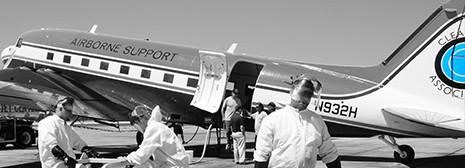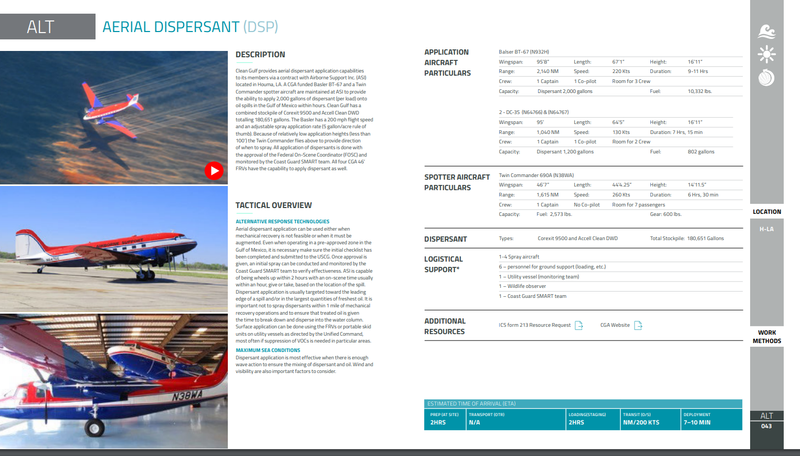Dispersants are toxic, and while they submerge oil spilled, and so will continue to be used in USA oil response, they can increase the uptake of oil by animals, including humans, in an oil spill response area. For more information, Follow the Alert Project, which has been collecting testimonies from response workers harmed by dispersant application, and spearheading national litigation to incorporate science of environmental and health impact into EPA policy on dispersant use.
Fishers and advocates are highly concerned with dispersant application on the Gulf and other oceans, and seek to track its use. Often, use of dispersants can cause more harm than good, and advocates would like to monitor changes in government policy as more research into the toxicity and effectiveness of dispersants is produced.
Dispersants are minimally effective unless there is a certain amount of wave action; but a large amount of wave action disperses the oil without any chemical additives. Advocates hope to limit dispersant use.
Corexit 9500 and 9527 are stockpiled for use in Alaska, but are used in the Gulf, despite the fact that they were not engineered for lighter Gulf oil.
In the past, the USCG provided flight paths for dispersant use, visible on the Gulf ERMA here:
downloadable here:
From recent news regarding citizen litigation against EPA:
Research also indicates that dispersants can have the unintended effect of transforming oil into a toxic mist able to travel for miles and penetrate deep into human lungs.
Arnesen, whose family fishes for Gulf shrimp, crab and reef fish, said she has suffered from respiratory problems and headaches years after exposure to dispersants while aboard a boat in Barataria Bay, an area hard-hit by the spill.
"Dispersant is nasty stuff to deal with," she told The Times-Picayune before the suit was filed. "You learn to live sick."
'Game-changer' ruling could restrict chemical dispersants on next big oil spill BY TRISTAN BAURICK | STAFF WRITER JUN 3, 2020
The Basler BT-67 Airplane on Clean Gulf Associates site, June 2020, appears to be a photo from the US Coast Guard in 2010. Its Tail Number is visible in the photo. There are two DC-3s that also perform this role. All Airplanes fly out of Houma (HUM), one of the DC-3s seems to be visible here

The other tail numbers are listed here
Balser BT-67 (N932H)
2 - DC-3S (N64766) & (N64767)
Twin Commander 690A (N38WA) --spotter plane

The Clean Gulf Association advertises its dispersant services online here.
[
Dispersants](http://www.cleangulfassoc.com/equipment/dispersant-aerial-application-systems-airborne-support-incorporated/)
- 4-hour Aerial Dispersant Response anywhere in the Gulf of Mexico
- BT-67 Basler is a modern Purpose Built Dispersant Spray Aircraft for operation in the U.S.
- "No Strings Attached" Dispersant Stockpile
http://www.cleangulfassoc.com/equipment/dispersant-stockpile/
DISPERSANT STOCKPILE
COREXIT
9500 is used to disperse oil spilled on the sea, thereby minimizing its environmental impact.
COREXIT 9500 is a high-performance, biodegradable, low toxicity oil spill dispersant that is effective on a wide range of oils, including the heavier, more weathered oils and emulsified oils. In addition to Corexit 9500, CGA's Fast Response Vessels may also use Corexit 9527 for limited application.
Aerial Spraying
Provides the most rapid method of applying dispersants to an oil spill and a variety of aircraft can be used for spraying. For aerial spraying the dispersants are applied undiluted. A typical treatment rate is two to ten US gallons per acre. Typical application altitudes of 30 to 50 feet have been used, although higher altitudes may be effective under certain conditions.
Boat Spraying The dispersants may also be used by boats equipped with spray booms, or fire water cannons. Handling and Storage This material can be stored in high density polyethylene, stainless steel, or double epoxy phenolic coated carbon steel containers. The containers should always be capped when not in use to prevent contamination and evaporation. Carbon steel and aluminum are not recommended for long-term storage. Have questions about dispersants, go here
http://www.cleangulfassoc.com/faq/
Who is Airborne Support, Inc. (ASI)?
Since the early 1990's, Houma, LA-based ASI has been a provider of aerial dispersant services. For CGA, they offer timely and reliable aerial dispersant application service anywhere in the Gulf of Mexico, by means of a modern turbo propeller-driven Basler BT-67 and two DC-3 aircraft, as well as spotter aircraft. They feature the most experienced aircrews and maintenance staff for aerial dispersant operations.
DISPERSANT AERIAL APPLICATION SYSTEMS: AIRBORNE SUPPORT INCORPORATED
Clean Gulf provides aerial dispersant application capabilities to its members via a contract with Airborne Support Inc. (ASI) located in Houma, LA. A CGA funded Basler BT-67 and a Twin Commander spotter aircraft are maintained at ASI to provide the ability to apply 2,000 gallons of dispersant (per load) onto oil spills in the Gulf of Mexico within hours. The Basler has a 200 mph flight speed and an adjustable spray application rate (5 gallon/acre rule of thumb). Because of relatively low application heights (less than 100') the Twin Commander flies above to provide direction of when to spray. All application of dispersants is done with the approval of the Federal On-Scene Coordinator (FOSC) and monitored by the Coast Guard SMART Team. All four CGA 46' FRVs have the capability to apply dispersant as well.
here's the tail numbers: https://flightaware.com/live/flight/N932H https://flightaware.com/live/flight/N64766 https://flightaware.com/live/flight/N64767 https://flightaware.com/live/flight/N38WA
The entire flight history is available for purchase here: https://flightaware.com/live/flight/N932H/history/buy
Another possible purchase here: https://www.flightradar24.com/data/aircraft/n932h
Reply to this comment...
Log in to comment
Ok. There are two easy aircraft tracking systems, ADSB and UAB. ADSB is commonly used on aircraft flying above 10,000 ft. UAB is more often used by lower flying aircraft. These both use a " dongle" available in the $20 price range. Or you can get dongle specifically designed for these applications, but the cost will be more.
Myself, I would try the $20 dongle first. While it does take a computer ( as do the others) it also allows you to listen to air traffic frequencies. This may also give you some of the information you need.
A good starting point is rtl-sdr.com . It will give a get started guide as well as plenty of articles an new applications for the dongles.
Good luck.
Reply to this comment...
Log in to comment
Sorry, that should be UAT, not UAB. Look up UAT.
Reply to this comment...
Log in to comment
Of you are using windows, start with SDR#. It's freeware. Start by listening to air traffic control in the local area. The new versions of SDR# include ADSB. IThat would be the next step. The Reddit rtlsdr is a good reference. I've been able to easily track planes from 150 miles with The included antenna.
The final step is the UAT.
Thank you @Ag8n !
Reply to this comment...
Log in to comment